The Famous Nishika N8000 3D Film Camera
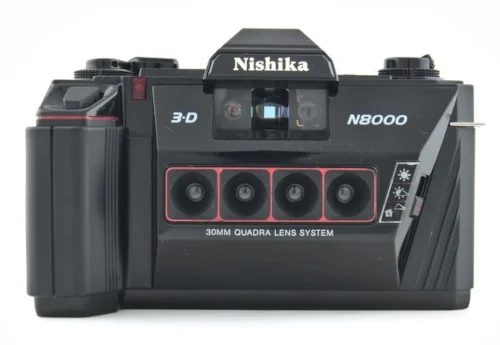
The Nishika N8000 is a quadrascopic stereo 3D lenticular camera. That is a long way of saying that it has 4 lenses.
- Can use color or black and white 35mm film
- Uses 2x AA batteries (not required)
Capturing a scene with four slightly different perspectives makes it possible to create “3D” lenticular prints. Lenticular prints were popular in the 1980s and early 1990s. Moving the print will change the image, creating a “3D” effect. It’s a fun novelty that did not require 3D glasses.
Unfortunately, Nishika Enterprises went out of business due to running a telemarketing scam. People didn’t think the camera was a prize worth up to $700, and complained to the FTC.
The Nishika N8000 can be thought of as a (significantly worse) successor to the Nimslo 3D camera. Nissei Corp. of Hong Kong bought the assets of the Nimslo company after bankruptcy and relaunched as Nishika.
Cameras were not sold in photography stores, but door-to-door. Nessei called it “direct selling,” but it was also criticized as being a multilevel scheme.
The Nishika camera didn’t last long as feedback and reviews at the time noted that it would often take 4-6 weeks or longer to get a lenticular print back. On top of that, the printing materials were of low quality so the 3D prints felt cheap.
N8000 Price & Where to Buy
For a few years the N8000 reached fad status for it’s history and the fact that it is a 4 lens camera. It was from the growth of analog photography and that there are few 3D film cameras to choose from. The Nimslo 3D Camera is a far superior product, though they do cost more.
You can find the Nishika N8000 for sale on:
Affiliate Advertising Disclosure
Outside the Shot is a participant in the Amazon Services LLC Associates Program, an affiliate advertising program designed to provide a means for sites to earn advertising fees by advertising and linking to Amazon.com.
As an eBay Partner, I may be compensated if you make a purchase. I also participate in affiliate advertising programs with KEH and Adorama. More can be found on the Affiliate Discolsure page.
Camera Battery - 2x AA
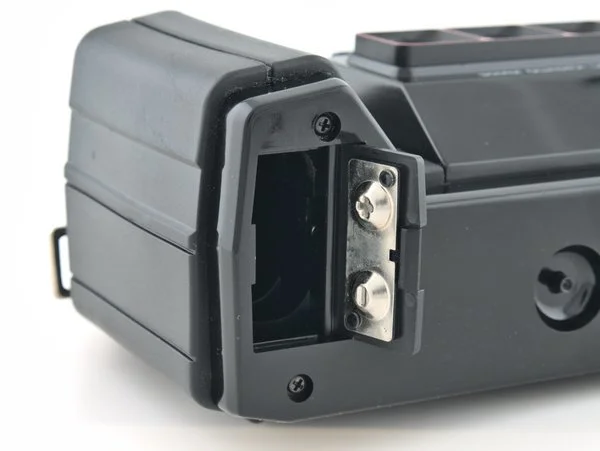
Two AA batteries are used to power a red LED. When lit up, the photograph will be underexposed. I tried using rechargeable Ni-MH batteries, as well as alkaline batteries, and the “meter” worked with both types.
The light meter is just a dot from a red LED that shows up in the center of the viewfinder. Half-pressing the shutter button on the Nishika 3D camera will turn it on. If a red dot appears, the image will be underexposed as there is not enough light available for a correct exposure.
Unlike with the Nimslo 3D, batteries are not required for the camera shutter to fire. There is also a battery check light.
Shutter Speed & Aperture
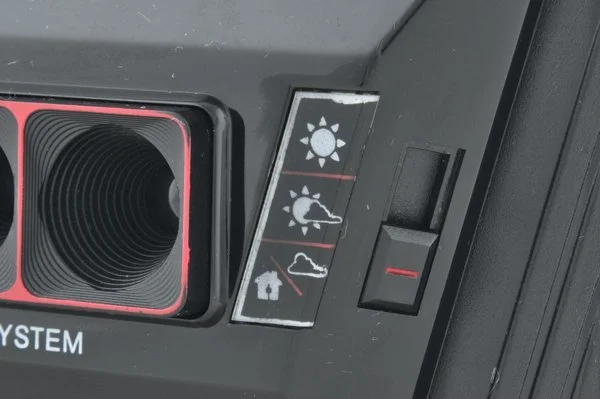
The N8000 owner’s manual lists the shutter speed as fixed at 1/60 second. Due to the age of the cameras and construction quality of the shutter mechanism, the shutter could be slower than 1/60th of a second.
- Sunny Day - f/19
- Partially Cloudy Day - f/11
- Cloudy Day / Indoors - f/8
There is no bulb mode or bulb feature. There is also no way to create a set of multiple exposure photos. A standard cable release can be screwed into a hole next to the shutter release.
The shutter sound and feedback are in line with what should be expected from a toy camera. None of the reviews on the camera out there praise it for having a great build quality.
The film advance is manual. As far as I know, there are no 3D or stereo cameras that use a motorized film advance.
There is a aperture switch next to the lenses that control the 3 aperture settings that can be used to control the depth of field and exposure. The settings need to be manually changed as there is no automatic exposure control. This is aperture range is limiting.
Quadra Lens System
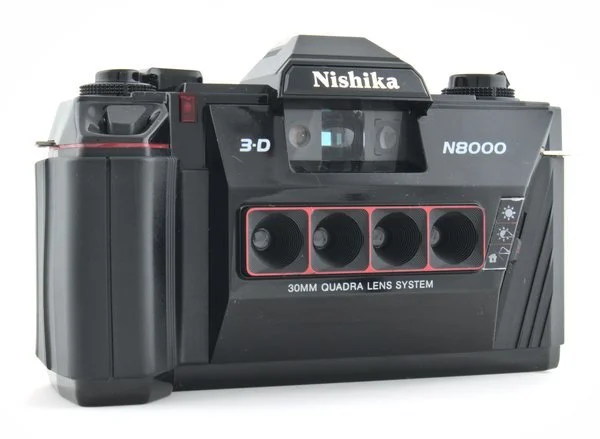
The four lenticular lenses are fixed in place, which means the focus is fixed. Everything 5.5 feet away to infinity will be in focus. The subject should be that far anyways as it will be difficult to frame photos closer than that due to the parallax error from the viewfinder.
At the smallest aperture of f/19, you’re also likely to see the effects of diffraction. Though it might be a moot point as the lenses are triplets.
You should not expect razor-sharp images from the camera. The slow fixed shutter also means motion blur can show up in pictures.
However, since the N8000 camera has glass lenses (I think it does), the performance will be better than the assortment of toy cameras using plastic lenses. It is also a quadrascopic camera, which there are only a handful of different 35mm 3D cameras to choose from.
It is not possible to use standard color filters with the camera as the quadra lens system does not have filter threads. You can hold or temporarily attach a filter or use some color gels or other improvised filter material.
Nishika N8000 Film Camera ASA/ISO Setting
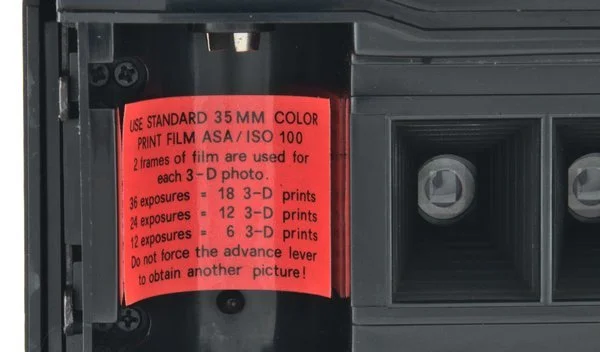
The Nishika N8000 has no way to change the ASA/ISO of the film the camera will meter for. It was designed with the use of ASA/ISO 100 35mm film.
If you’re comfortable with manual exposure, a light meter like the Minolta Auto Meter VF, can be used instead of the built-in camera meter. With a handheld meter, you will be able to use any film you want.
Due to the limitations of the shutter and apertures, a flash is going to be nice to have. The Twin Light 3010 is only going to work with ISO 100 film.
A flash with manual controls will be a better choice. By using a light meter, changing the flash output can be used to control the depth of field. It will also allow you to calculate the correct exposure when using ISO 200 or ISO 400 speed films.
Film Processing
Nishika N8000 Film Processing is done the same way as other cameras. However, if the film is being sent to a lab, ask them not to cut the film. This will prevent frames being cut in a way that would ruin one of the 4 photos.
Viewfinder
The viewfinder has more than 100% coverage of the image area. There are 4 frame indicators in the corners showing the area that will be covered by the four images.
I’m not sure if the viewfinder would be considered a rangefinder because you have no control over focus.
The important thing to note is that you’re not seeing through a lens, like on an SLR. Due to this, you might encounter a parallax error if you’re taking photos of a close subject.
Metering
Pressing the shutter halfway down will activate the camera’s meter.
The light meter on the N8000 will show a green dot in the viewfinder if the camera thinks the film will be exposed properly. A red dot will show if the image would be over or underexposed.
The meter is taking ambient light reading at the location of the photodiode, next to the viewfinder. This is different from the through the lens metering found in SLRs.
Expect the camera meter to be far from accurate. You will get better results, and have the ability to use film speeds other than ISO 100 with a handheld light meter.
Camera Features
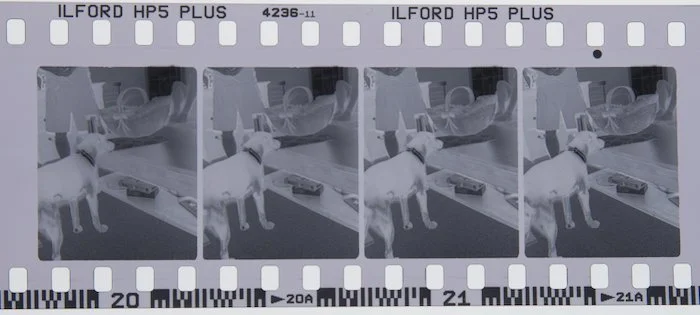
Instead of using a single frame, the Nishika N8000 uses 2 frames of film from a roll of 35mm film to produce 4 images. Each Nishika photo takes up half a standard frame (36mm x 24mm). You’ll end up with 4 18mm x 24mm images.
Using 2 frames means that you’ll get half as many shots as what is stated on a roll of film. As such, the frame counter only goes up to 18.
| 35mm Film Roll Size | # of Nishika Shots |
|---|---|
| 36 Exposure Roll | 18 Shots |
| 24 Exposure Roll | 12 Shots |
| 12 Exposure Roll | 6 Shots |
Negatives
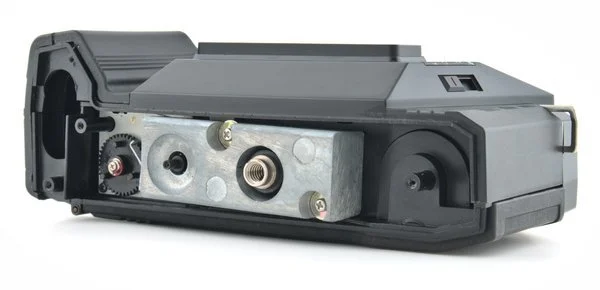
There is a metal weight in the bottom of the Nishika N800 to give a “premium” feel.
The top “LCD” screen on the camera, isn’t actually an LCD screen. It is just plastic.
There is a 4 ounce metal weight in the bottom of the camera. This was put there to give the camera a more “premium” feel. It can be removed if you want.
Beyond that, the camera body is significantly larger than it needs to be. There doesn’t need to be a hump as the camera does not have a pentaprism.
The only reason the camera has a huge plastic body is for marketing. Bigger is better? With the body the size that it is, you’d expect it to have motorized film advance instead of relying on a manual film advance lever.
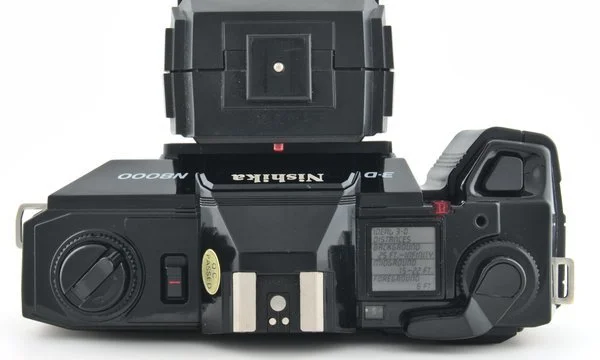
There are 2 fake contacts on the hot shoe. These do not connect to the Nishika Twin Flash 3010.
Turning 3D Photos Into GIFs
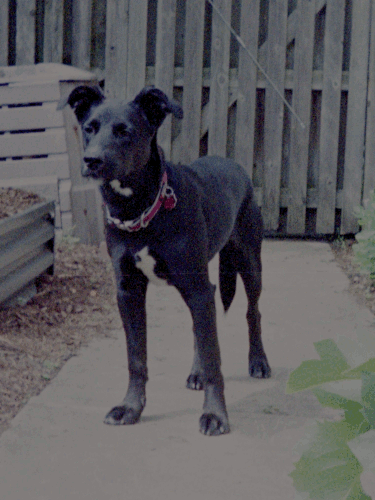
After digitizing the four frames they can be aligned and turned into an animated GIF. This will give a “bullet time” effect.
My problem has been on figuring out how to align the 4 frames with each other, how long the delay should be in the animation, and the time involved in the creation of a GIF.
Currently, it requires more work than I care to do for results I’m not happy with. Once I figure out an efficient workflow, I will replace this section with it.
Accessories
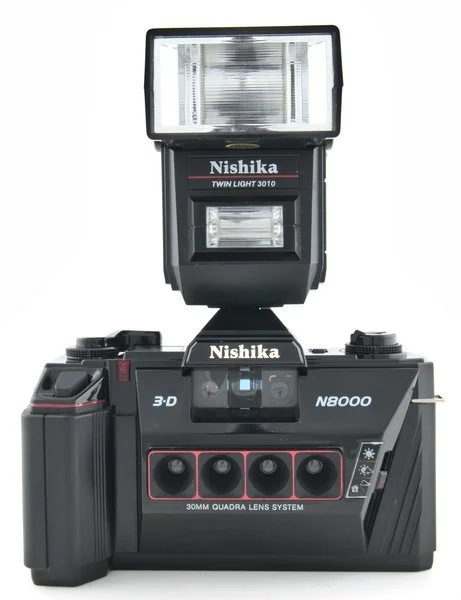
There were a bunch of cheap poorly reviewed accessories and products originally included with the N8000.
Other than the Twin Light flash, I would not going looking through Amazon or another site to try to find any of these.
- “Professional” Strap
- Deluxe Camera Case (Made of vinyl)
- Nishika Tripod
- Lens Cleaning Kit
- Nishika branded color film
- VHS instructional tape hosted by Vincent Price
- Nishika N8000 Owner’s Manual
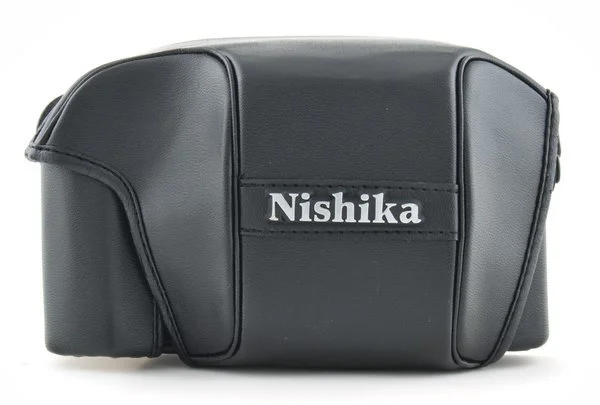
Nishika Twin Light 3010 Flash
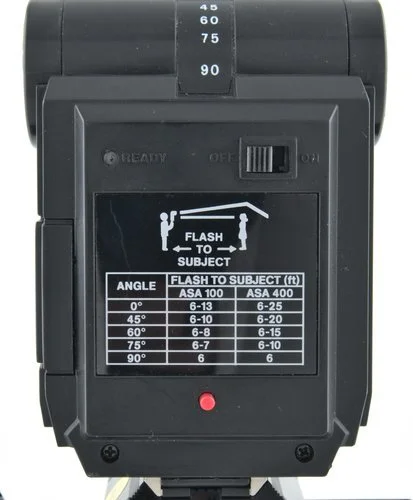
The Nishika Twin Light 3010 has two flashes and was the companion flash released with the camera. The Nishika N8000 flash has a ready light, on/off switch, test button, and flash to subject distance chart.
One is front-facing, while the other can rotate 90 degrees up and down. The idea is to bounce the upper flash off of a ceiling and the lower flash will illuminate the subject.
The Nishika Twin Light 3010 flash can be found on:
There is a ready light, on/off switch, test button, and flash to subject distance chart.
Owner’s Manual
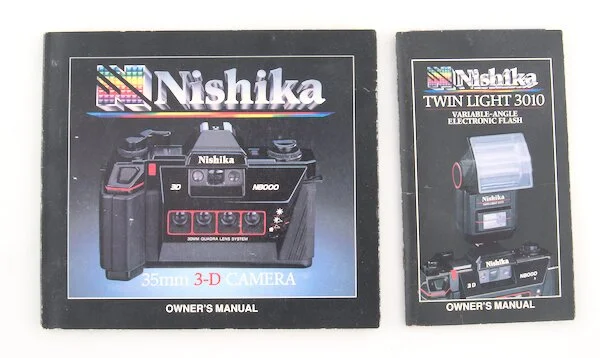
You can find a PDF scan of the original camera manual at Butkus.org. This a helpful reference resource if you are not familiar with film cameras.
Mini Camera Review
My Rating: 3 out of 5 stars
Can you put a price on fun?
Yes, and the N8000 comes with a rather large price tag for what you get. If the camera was widely available for $25, it would be a 5-star camera.
Is it worth the price? That depends on if your willing to work around some of the deficiencies the camera has and how badly you want 3D images.
The camera is larger and bulkier than it needs to be. I’m not surprised that they later came out with the N9000, which is similar in size to the Nimslo.
Compared to the Nimslo 3D camera, it lacks the automatic exposure mode and range of shutter speeds. This may or may not be a problem for you.
I don’t mind because it is possible to use a light meter to calculate the required power output from a flash to get a correct exposure. If you’re not comfortable with that, stick with 100 ISO film.
Alternative Cameras
There are other cameras with three or four lenses that you may be able to find. The stereo cameras are older, better built, but only take 2 images at a time.
Lenticular Lens Options
- Nishika N9000
- Nimslo 3D
- Minitech Quadra Lens
- ImageTech 3Dfx, ImageTech 3D Wizard, 3D Magic, Kalimar 3D Stereo Camera
- Trio Automatic
- Reto 3D
Stereo Cameras
- Stereo Realist
- Busch Verascope F40
- View Master Personal
- Stereocrafters Videon
- Graflex Stereo Graphic
For more information, you can check out http://paul67.fc2web.com/. The website is in Japanese, but a Chromium based browser should be able to translate the page for you.
Resources
Hack Your Nishika N8000 - This was written in 2011. It covers modifying the camera to add the ability to do double exposures, multiple exposures and long exposures by adding a bulb function.
Having a bulb feature would be nice. An alternative is to get a Nimslo 3D and reverse the polarity (put them in backwards) of the batteries.